
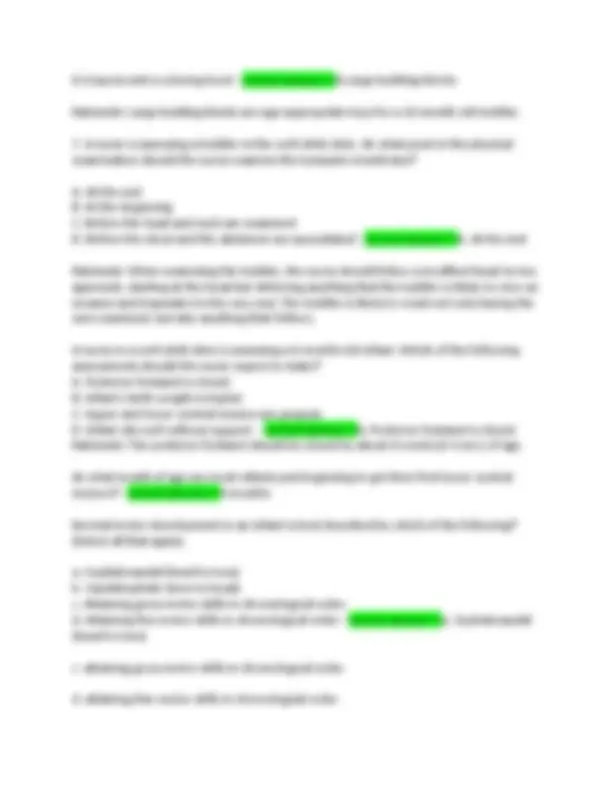
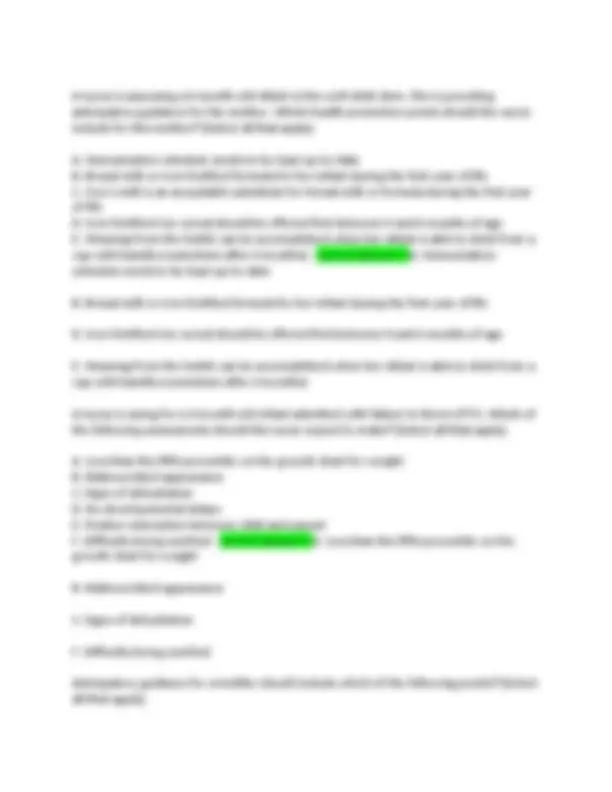
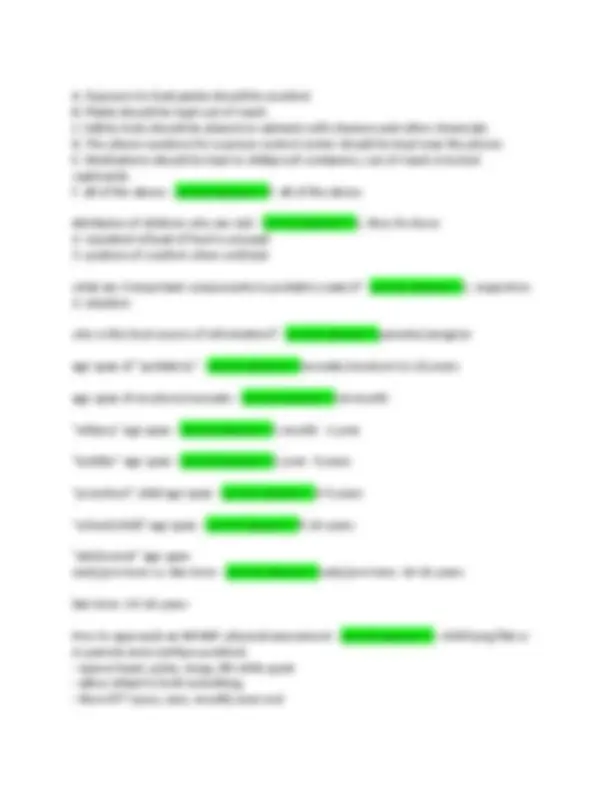
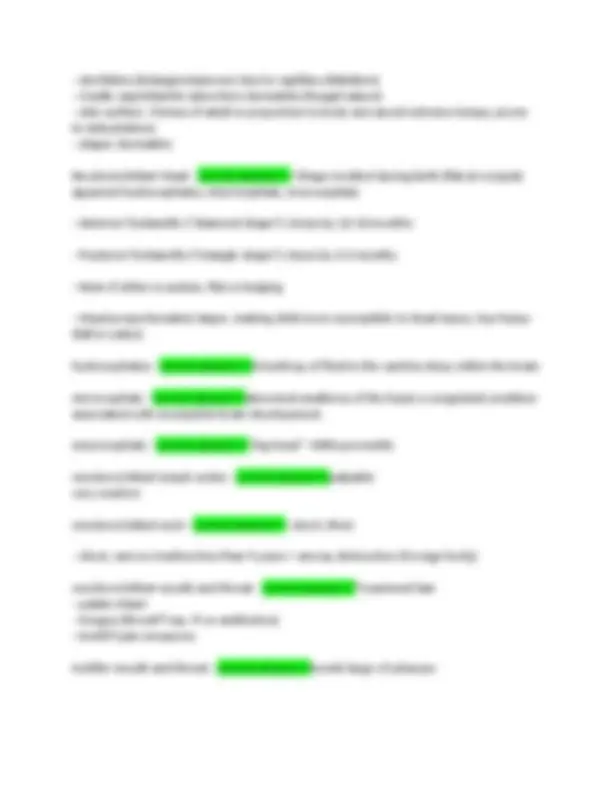
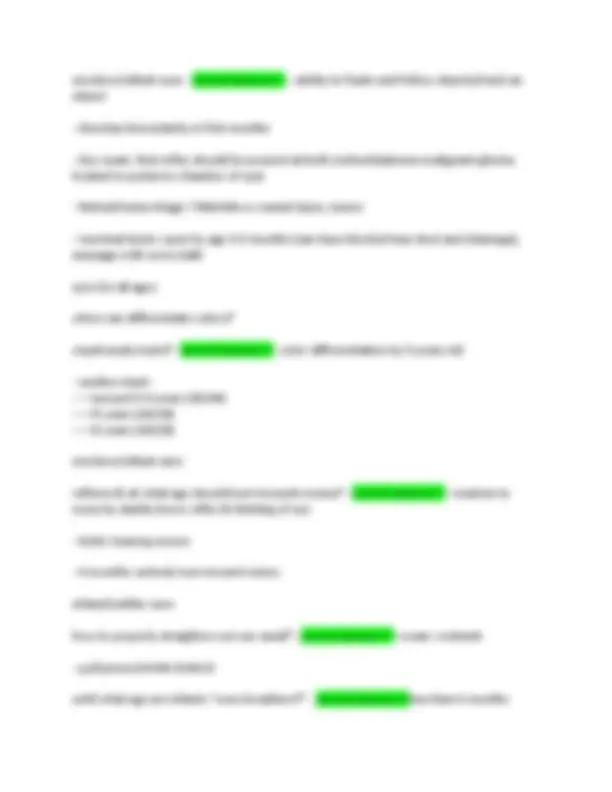
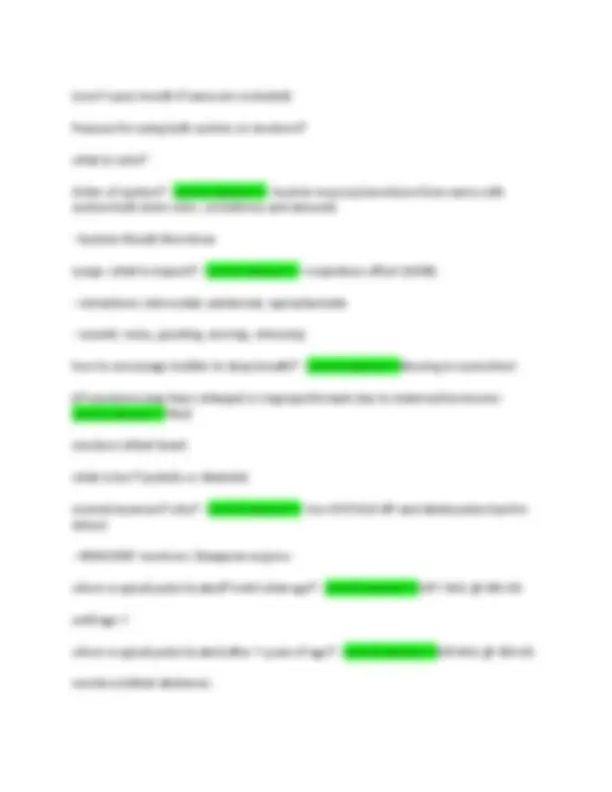
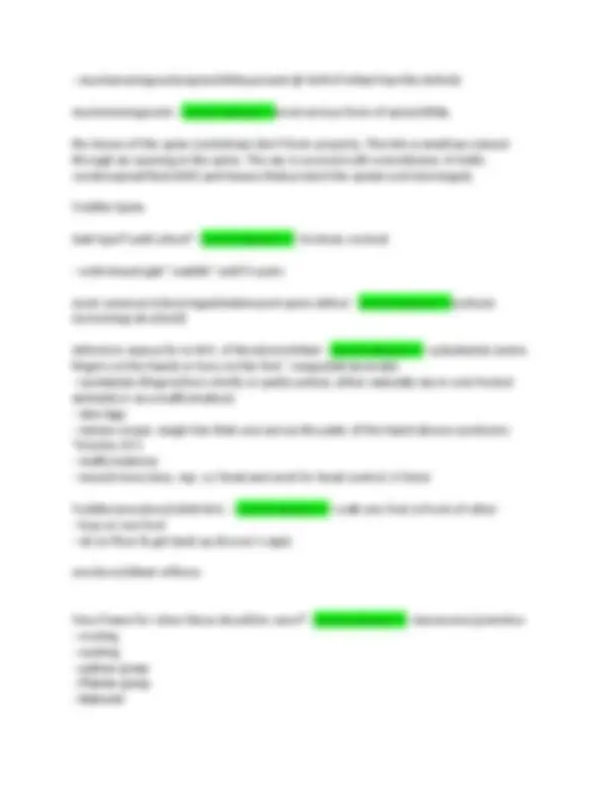
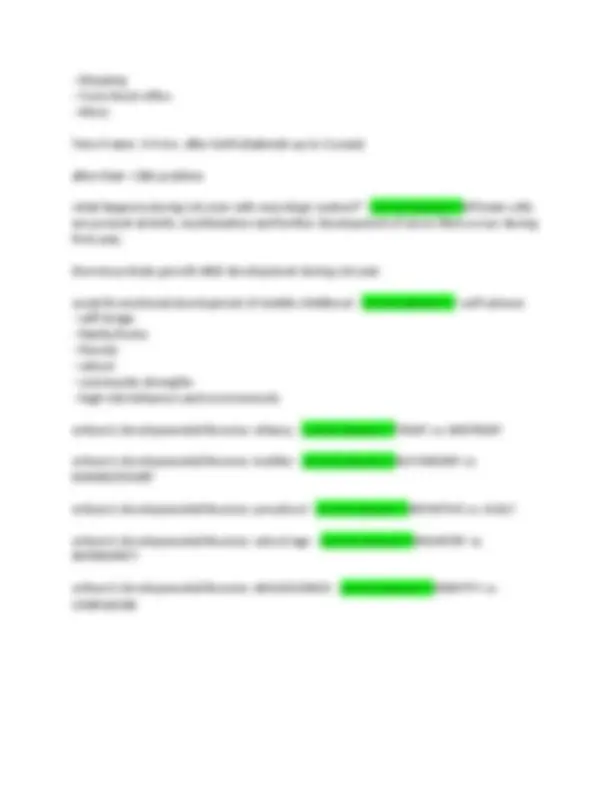


Study with the several resources on Docsity

Earn points by helping other students or get them with a premium plan


Prepare for your exams
Study with the several resources on Docsity

Earn points to download
Earn points by helping other students or get them with a premium plan
Community
Ask the community for help and clear up your study doubts
Discover the best universities in your country according to Docsity users
Free resources
Download our free guides on studying techniques, anxiety management strategies, and thesis advice from Docsity tutors
A nurse is providing health promotion teaching to the parents of an infant. Which of the following is the leading cause of death among this age group. A.Congenital anomalies B.Respiratory distress C.Unintentional injuries D.Sudden Infant death syndrome - correct answer>>A. Congenital anomalies 2. A nurse is assessing a 3-month-old. Which of the following findings should reported to the provider. A.Unable to raise head when in prone position B.Unable to sit without support C.Unable to pick up an object with his fingers D.Unable to bring an object to his mouth - correct answer>>A.Unable to raise head when in prone position Rationale: A 3-month-old should be able to raise their head and shoulders from prone position; therefore this should be reported to the provider. at what month should infant be able to sit without support? - correct answer>>8 months
Typology: Exams
1 / 14

This page cannot be seen from the preview
Don't miss anything!









A nurse is providing health promotion teaching to the parents of an infant. Which of the following is the leading cause of death among this age group. A.Congenital anomalies B.Respiratory distress C.Unintentional injuries D.Sudden Infant death syndrome - correct answer>>A. Congenital anomalies
E. Position the crib away from windows.
A nurse is assessing a 4-month-old infant in the well-child clinic. She is providing anticipatory guidance for the mother. Which health promotion points should the nurse include for this mother? (Select all that apply). A. Immunization schedule needs to be kept up-to-date B. Breast milk or iron-fortified formula for her infant during the first year of life C. Cow's milk is an acceptable substitute for breast milk or formula during the first year of life D. Iron-fortified rice cereal should be offered first between 4 and 6 months of age E. Weaning from the bottle can be accomplished when her infant is able to drink from a cup with handles (sometime after 6 months) - correct answer>>A. Immunization schedule needs to be kept up-to-date B. Breast milk or iron-fortified formula for her infant during the first year of life D. Iron-fortified rice cereal should be offered first between 4 and 6 months of age E. Weaning from the bottle can be accomplished when her infant is able to drink from a cup with handles (sometime after 6 months) A nurse is caring for a 9-month-old infant admitted with failure to thrive (FTT). Which of the following assessments should the nurse expect to make? (Select all that apply). A. Less than the fifth percentile on the growth chart for weight B. Malnourished appearance C. Signs of dehydration D. No developmental delays E. Positive interaction between child and parent F. Difficulty being soothed - correct answer>>A. Less than the fifth percentile on the growth chart for weight B. Malnourished appearance C. Signs of dehydration F. Difficulty being soothed Anticipatory guidance for a toddler should include which of the following points? (Select all that apply).
A. Exposure to lead paints should be avoided. B. Plants should be kept out of reach. C. Safety locks should be placed on cabinets with cleaners and other chemicals. D. The phone numbers for a poison control center should be kept near the phone. E. Medications should be kept in childproof containers, out of reach in locked cupboards. F. all of the above - correct answer>>F. all of the above Attributes of children who are sick - correct answer>>1. they lie down
Periods of sinus arrhythmia-- HR increases with inspiration and decreases with expiration. How to assess respirations? at what age is it normal to be irregular? - correct answer>>Observe chest rise and/or use stethoscope for 1 full minute. infants = irregular How to assess BP in neonates/infants? Hypertension charts in pediatric population? - correct answer>>may take in lower extremities; cuff selection is essential, position, and site. --prehypertension BP 90-95% for age & height --hypertension BP > 95% for age & height How to assess for pain? what is determining factor for how to assess pain? - correct answer>>age determines the scale. N-Pass, FLACC, FACES, 0-10 Pain Scale For growth chart: what % range is considered "normal" what "factors" are plotted? - correct answer>> 5 - 95% height/weight/head circumference where/when to measure head circumference? - correct answer>>OFC = occipital-frontal supraorbital ridge continue up to 2 years of age. newborn/infant skin hair nails? - correct answer>>--Appear very "reddish" --acrocyanosis (hands/feet bluish-purple and rest of body pink) --Lanugo or Vernix caseosa (white, cheesy coating on skin) --Milia (newborn acne = hormones) --Mongolian spots (not bruise, normal in AA, Latino, Oriental ethnic groups)
--storkbites (telangiectasia nevi due to capillary dilatation) --Cradle cap/infantile seborrheic dermatitis (fungal nature) --skin surface: 3 times of adult in proportion to body size (avoid extreme temps; prone to dehydration) --diaper dermatitis Newborn/Infant Head - correct answer>>--Shape molded during birth (flat at occiput) apparent hydrocephalus, macrocephaly, microcephaly --Anterior fontanelle-("diamond shape") closes by 12-18 months --Posterior fontanelle-("triangle shape") closes by 2-3 months --Note if either is sunken, flat or bulging --Head proportionately larger, making child more susceptible to head injury; top-heavy (fall in water) hydrocephalus - correct answer>>A build-up of fluid in the cavities deep within the brain microcephaly - correct answer>>abnormal smallness of the head, a congenital condition associated with incomplete brain development. macrocephaly - correct answer>>"big head" >98th percentile newborn/infant lymph nodes - correct answer>>palpable very reactive newborn/infant neck - correct answer>>--short, thick --short, narrow trachea less than 5 years = airway obstruction (Foreign body) newborn/infant mouth and throat - correct answer>>*examined last --palate intact --tongue (thrush? esp. if on antibiotics) --teeth? pain measures. toddler mouth and throat - correct answer>>tonsils large r/t pharynx
(won't open mouth if nares are occluded) Purpose for using bulb suction on newborn? what to note? Order of suction? - correct answer>>--Suction mucous/secretions from nares with suction bulb (note color, consistency and amount) --Suction Mouth then Nose Lungs: what to inspect? - correct answer>>--respiratory effort (WOB) --retractions: intercostal, substernal, supraclavicular --sounds: noisy, grunting, snoring, wheezing how to encourage toddler to deep breath? - correct answer>>blowing in a pinwheel t/f newborns may have enlarged or engorged breasts due to maternal hormones - correct answer>>TRUE newborn infant heart: what is low? (systolic or diastolic) normal murmurs? why? - correct answer>>--low SYSTOLIC BP and distal pulses hard to detect --INNOCENT murmurs: disappear as grow. where is apical pulse located? Until what age? - correct answer>>LEFT MCL @ 4th ICS until age 7 where is apical pulse located after 7 years of age? - correct answer>>left MCL @ 5th iCS newborn/infant abdomen:
umbilicus inspection - correct answer>>--umbilicus: pink w/o redness or drainage --cord: dark brown; falls off (7-10 days) --inguinal or umbilical hernias? (Common in AA) infant-preschool abdomen: normal appearance - correct answer>>prominent & protruding "waddling" gait Preschool and on abdomen: normal appearance - correct answer>>flattens male newborn genitalia exam by what age do testicles need to descend into scrotum? - correct answer>>--foreskin retractable 3 months --opening of meatus (hypospadiasis: below, epispadiasis: above) --note "micropenis" (<0.5cm) --Before age 1: both testicles descend into scrotum (surgery--orchiopexy) male genitalia all ages: assessment/findings - correct answer>>--redness --discharge --laceration (abuse?) female newborn genitalia - correct answer>>--ambiguous genitalia? (labia, clitoris, enlarged? misshaped?) --hormones: initial enlargement/discharge when should adolescent female get internal GYN exams? - correct answer>>once female is sexually active or or if gynecological problems.
--myelomeningocele/spina bifida present @ birth if infant has this defect) myelomeningocele - correct answer>>most serious form of spina bifida. the bones of the spine (vertebrae) don't form properly. This lets a small sac extend through an opening in the spine. The sac is covered with a membrane. It holds cerebrospinal fluid (CSF) and tissues that protect the spinal cord (meninges). Toddler Spine Gait type? until when? - correct answer>>--lordosis: normal --wide-based gait "waddle" until 5 years most common School-Aged/Adolescent spine defect - correct answer>>scoliosis (screenings at school) defects to assess for in M.S. of Newborn/Infant - correct answer>>--polydactyly (extra fingers on the hands or toes on the feet. 'congenital anomaly) --syndactyly (fingers/toes wholly or partly united, either naturally (as in web-footed animals) or as a malformation) --skin tags --simian crease: single line that runs across the palm of the hand (downs syndrome "trisomy 21") --malformations --muscle tone (imp. esp. w/ head and neck for head control: 2-5mo) Toddler/preschool/child M.S. - correct answer>>--walk one foot in front of other --hop on one foot
--Stepping --Tonic Neck reflex --Moro Time Frame: 3-4 mo. after birth (babinski up to 2 years) after that---CNS problem what happens during 1st year with neurologic system? - correct answer>>All brain cells are present at birth, myelinization and further development of nerve fibers occur during first year; Enormous brain growth AND development during 1st year. social & emotional development of middle childhood - correct answer>>--self-esteem --self-image --family/home --friends --school --community strengths --high-risk behaviors and environments erikson's developmental theories: infancy - correct answer>>TRUST vs. MISTRUST erikson's developmental theories: toddler - correct answer>>AUTONOMY vs. SHAME/DOUBT erikson's developmental theories: preschool - correct answer>>INITIATIVE vs. GUILT erikson's developmental theories: school-age - correct answer>>INDUSTRY vs. INFERIORITY erikson's developmental theories: ADOLESCENCE - correct answer>>IDENTITY vs. CONFUSION